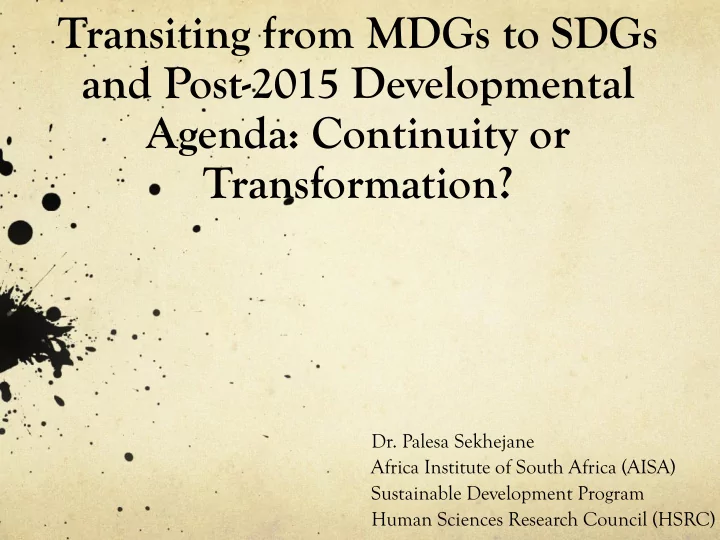

Transiting from MDGs to SDGs and Post-2015 Developmental Agenda: Continuity or Transformation? Dr. Palesa Sekhejane Africa Institute of South Africa (AISA) Sustainable Development Program Human Sciences Research Council (HSRC)
Introduction Africa suffers from compromising the core developmental matter for material wealth and the “under-developing” power. Conflicts, violence, wars and colonial system(s) resulted in deepened insult to the human development essentials (i.e. health & education) and infrastructure. Declarations upon declarations - Alma Ata Declaration of 1978, Health for all in the 21st century, the Abuja and Ouagadougou Declarations.
Introduction Alma Ata Declaration of 1978, Health for all in the 21st century, the Abuja and Ouagadougou Declarations. Another epoch of post-2000, known as the Millennium Development Goals (MDGs) has passed. MDG set to achieve 8 goals by 2015, including gender parity/equality and health related goals. Given the progress made in the developed nations such as North America and Europe, Africa still lags behind in achieving envisaged developmental goals. Post-2015 Sustainable Development Goals (SDGs) epoch.
MDGs and Africa Sub-Saharan Africa has slow progress towards achieving MDGs – human or gender development, equality/parity, preferential access to education (patrimonial). Analysis of Health and Gender MDGs – which one is progressed than the other Necessary synergy in decision and policy making
MDG 3 – Gender Equality Eliminate gender disparity in primary and secondary education, preferably by 2005, and in all levels of education no later than 2015. - Ratios of girls to boys in primary, secondary and tertiary education. - Share of women in wage employment in the non- agricultural sector. - Proportion of seats held by women in national parliament.
MDG Synopsis
MDG 4 & 5 – Health MDGs Goal 4: Under-five mortality rate – Under-5 mortality rate; Infant mortality rate and Proportion of 1 year-old children immunized against measles. Goal 5: Improve maternal health - Reduce maternal mortality; and universal access to reproductive health
Gender - Developmental Tool It is an intrinsic rather than an instrumental goal, explicitly valued as an end in itself rather than as an instrument for achieving other goals. Translation of this goal is rather insufficient and poorly conceptualized. Indicators do not emphasize social and psychological freedom – which may essentially lead to development of women and men. Socio-Cultural change – culture plays a huge role in shaping gender equality.
Health - Developmental Tool The existing historical infrastructure inequalities have potentially contributed to “infrastructure-inequality” trap that hinders equitable distribution of funds to those with greater needs, which exacerbates the current health care system inequalities. Health care system is a social benefit left for a privilege of the few – equitable access for all should prevail. Negative image of Africans as being unproductive is linked to health care.
Recommendations and Conclusion One's sense of being male or female largely determines how people view themselves and provides an important basis for their interactions with others – sociocultural education. Gender conscious nation is essentially a nation striving for human development and accelerated social security. Capitalize on primary education and adolescent age. Easterly (2009) strongly asserts that the conceptualisation of MDGs is capricious and distorted as they were set in a way that will make Africa be in an unfavourable side to attain them, thus making Africa look like a failure. Due to economic underdevelopment, Africa started with the lowest per capita income which would not make the continent effectively achieve the reduction of poverty by 50 percent come 2015. Further, disempowerment tools such as Structural Adjustment Programmes disguised as an outreach programmes, had fatal effects on the development of Africa and yet Africa continues to consume the myths projected by the MDGs.
Recommend
More recommend